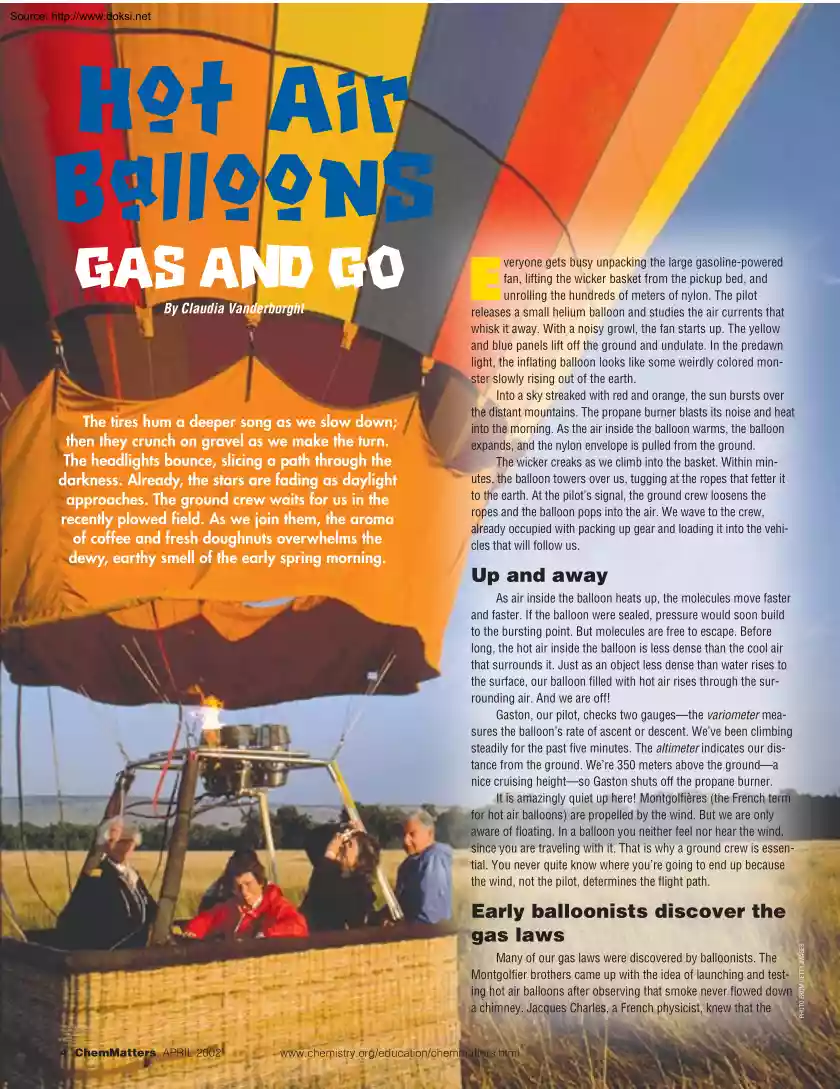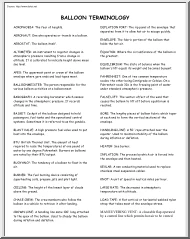Datasheet
Year, pagecount:2002, 3 page(s)
Language:English
Downloads:4
Uploaded:August 23, 2018
Size:757 KB
Institution:
-
Comments:
ChemMatters,
Attachment:-
Download in PDF:Please log in!
Comments
No comments yet. You can be the first!Most popular documents in this category
Content extract
Source: http://www.doksinet Hot Air BalloonS GAS AND GO By Claudia Vanderborght The tires hum a deeper song as we slow down; then they crunch on gravel as we make the turn. The headlights bounce, slicing a path through the darkness. Already, the stars are fading as daylight approaches. The ground crew waits for us in the recently plowed field. As we join them, the aroma of coffee and fresh doughnuts overwhelms the dewy, earthy smell of the early spring morning. E veryone gets busy unpacking the large gasoline-powered fan, lifting the wicker basket from the pickup bed, and unrolling the hundreds of meters of nylon. The pilot releases a small helium balloon and studies the air currents that whisk it away. With a noisy growl, the fan starts up The yellow and blue panels lift off the ground and undulate. In the predawn light, the inflating balloon looks like some weirdly colored monster slowly rising out of the earth. Into a sky streaked with red and orange, the sun bursts over the
distant mountains. The propane burner blasts its noise and heat into the morning. As the air inside the balloon warms, the balloon expands, and the nylon envelope is pulled from the ground. The wicker creaks as we climb into the basket. Within minutes, the balloon towers over us, tugging at the ropes that fetter it to the earth. At the pilot’s signal, the ground crew loosens the ropes and the balloon pops into the air. We wave to the crew, already occupied with packing up gear and loading it into the vehicles that will follow us. Up and away Early balloonists discover the gas laws Many of our gas laws were discovered by balloonists. The Montgolfier brothers came up with the idea of launching and testing hot air balloons after observing that smoke never flowed down a chimney. Jacques Charles, a French physicist, knew that the 4 ChemMatters, APRIL 2002 www.chemistryorg/education/chemmattershtml PHOTO FROM GETTY IMAGES As air inside the balloon heats up, the molecules move faster
and faster. If the balloon were sealed, pressure would soon build to the bursting point. But molecules are free to escape Before long, the hot air inside the balloon is less dense than the cool air that surrounds it. Just as an object less dense than water rises to the surface, our balloon filled with hot air rises through the surrounding air. And we are off! Gaston, our pilot, checks two gaugesthe variometer measures the balloon’s rate of ascent or descent. We’ve been climbing steadily for the past five minutes. The altimeter indicates our distance from the ground We’re 350 meters above the grounda nice cruising heightso Gaston shuts off the propane burner. It is amazingly quiet up here! Montgolfières (the French term for hot air balloons) are propelled by the wind. But we are only aware of floating. In a balloon you neither feel nor hear the wind, since you are traveling with it. That is why a ground crew is essential You never quite know where you’re going to end up because
the wind, not the pilot, determines the flight path. PHOTOS COURTESY OF THE LOWELL SCHOOL, WASHINGTON, DC Source: http://www.doksinet is much colder at higher altitudes. As a general rule, the temperature drops 10 °C for every kilometer of ascent. Sunlight dances on the hills below us, adorned with the lacy greens of spring foliage. We’ve been aloft for nearly an hour when Gaston radios the ground crew to discuss suitable landing sites. Ballooning is safest during dawn or dusk Our morning air is becoming bumpy with turbulence. Warmed by the sun, the air rising from the hills reaches us sooner than the air from the valleys. As a result, we lose altitude in the less dense warm air, but we are quickly buoyed up as we drift over the valley. It’s fun, but our thermal roller coaster ride can become dangerous if the pilot loses control over the balloon. Different materials heat up at different rates. Air over a recently plowed field will heat up and cool down faster than air over a
lake. As the sun climbs higher and shines directly down on the earth, these thermal contrasts become more intense. In preparation for landing, Gaston pulls the cord to the vent. Hot air at the balloon’s apex escapes, cool air rushes into the appendix to replace it. We slowly descend as our balloon becomes filled with denser air. Finally, gravity wins Landings can be a little rough, but Gaston is an experienced pilot. Just before we land, he pulls the rip cord, which opens the top of the balloon and deflates it behind us. The wicker basket flexes and creaks as we touch ground, Students at the Lowell School in Washington, DC, make absorbing most of the landing energy, so careful measurements as they construct their balloons. that the passengers are barely upset. The ground crew rushes up with smiles, paper cups, and a bottle of champagne. It’s the tradimeters of nylon Deflated, it weighs 85 kilotional French way to celebrate a successful grams (about 190 pounds). Inflated, however,
balloon flight. our balloon displaces nearly three tons of air! CLIP ART FROM ACS FILES newly identified hydrogen gas would lift balloons far better than hot air. His first experiment, launched from Paris, was supremely successful! The unmanned balloon shot a mile into the sky and eventually landed 25 km away, terrifying the peasants, who hacked at the flying “monster” with pitchforks until it no longer “breathed”. Charles’ lawthe volume of a gas will increase as its temperature increases, when kept at a constant pressureis named after its discoverer. Professor Charles applied his discovery to making improvements to the airships. Early flights were brief because the balloons quickly deflated. The buoyant gases escaped through the silk fabric’s weave. Charles coated the silk with rubber dissolved in turpentine, sustaining flights by slowing the diffusion of hydrogen or hot air from the balloon. He suggested adding a vent to the top of the balloon. The vent allows pilots to
release gas from the apex, thus giving them control over the descent. Early balloons had an alarming tendency to explode. Pilots, hoping to set new altitude records, heated the flammable hydrogen to decrease its density. Not surprisingly, some met their deaths in spectacular, fiery crashes. Sometimes the inexperienced balloonist failed to balance the amount of air inside the envelope with the rate at which it was heated. The rapid ascent to high altitudes The flight ceiling strained the silk beyond the tolerance limit. The balloon burst, plunging the occupants to their untimely deaths. Our balloonist Gaston fires the burner again, reheating the air to regain our lost altitude. It’s good to know that skirts of contemporary balloons are treated with a flame retardant. The average sporting balloon stands about seven stories tall and, depending on its design, is made from about 1000 square As the density of the balloon approaches the density of the surrounding air, our ascent levels
off. We’ve reached our flight ceiling at 1500 meters (or about 5000 feet) above sea level. Many balloons attain even greater altitudes, but flying conditions deteriorate and danger increases. The air pressure at 3000 meters is barely 70% of the pressure at sea level. As the total pressure decreases, the partial pressure of oxygen also decreasesmaking it more difficult to ignite the propane Or to breathe! Many early balloonists lost their lives by suffocation as they tried to set higher altitude records. The lucky ones only lost their fingers and toes to frostbite, since air Claudia Vanderborght is a high school chemistry teacher and science writer in Swanton, VT. Her recent article “Maple Syrup: Sweet Sap Boils Down to This” appeared in the February 2002 issue of ChemMatters. REFERENCES Bloomfield, L. A How Things WorkThe Physics of Everyday Life; Wiley & Sons: New York; Chapter 3.1 Flynn, M. The Great Airships; Carleton Books Ltd.: London, 1999 Norwood, A. Taming the
Gentle Giant: A Guide to Hot Air Ballooning; Taylor Publishing Co.: Dallas, TX, 1986 Schaefer, V. J; Day, J A A Field Guide to the Atmosphere; Houghton Mifflin Co.: Boston, 1981. ChemMatters, APRIL 2002 5 Try it! Make Your Own ILLUSTRATION FROM ACS GRAPHICS CLIPART FILE ACTIVITY: Source: http://www.doksinet Hot Air Balloon Make your own hot air balloons and launch them from your school grounds. Although there is probably little risk of terrifying the local “peasants” with your “monsters”, it’s a good idea to get clearance from local authorities before you launch. Build it 1. Prepare a total of 8 panels of tissue paper by Assemble materials gluing together three separate sheets as shown in (a). 24 sheets of tissue paper, various colors 2. Scissors (a) Glue (b) 80 cm Masking tape Thermometer 80 cm Hole for thermometer in one of the gores. 50 cm String and/or streamers cut from tissue paper Small camp stove with fuel 60 cm Short section of stovepipe Short
ladder for standing while you read the thermometer Next, stack the panels and staple them together at the corners. Trim the stack of panels to make 8 "gores" with the dimensions shown in (b). 50 cm 60 cm 75 cm 75 cm Heatproof mits for handling the hot stovepipe Fire extinguisher 17 cm cm 17 Balance suitable for weighing the balloon assembly 3. Determine the mass of your balloon assembly Do this if you are going to do the calculations your teacher may assign at the end of the activity. After the glue dries, gently fold the balloon. Either weigh it directly, or weigh it enclosed in a tared container. Check for safety Do this activity outdoors on a nonwindy day, away from flammable materials. These directions are for supervised classes only. Have a fire extinguisher on site, and review instructions for using it. Wear heatproof mits when handling the hot stovepipe. readings are important for doing the calculations your teacher may assign. Punch a small hole in the top
section of the balloon, just big enough to lower a thermometer suspended on a string Ignite a small camp stove, and surround it with a few upended bricks. Place your stovepipe section over the camp stove. Position the bottom of the balloon over the stovepipe, and hold the balloon while it inflates with the warm air. Try to adjust the heat to the point where the balloon just “hovers”, neither rising nor falling. Note this temperature Then, increase the temperature a few more degrees, remove the ther, mometer, stand back, and let er go! Think about it Launch it Record the outside air temperature at time of launch. These temperature 6 ChemMatters, APRIL 2002 Separate the gores. Glue each edge to a neighboring gore to form the balloon Reinforce the open bottom edge with masking tape, and attach several evenly spaced streamers and/or pieces of string to the bottom. These should increase the stability of your balloon. Assuming your balloon survives intact, try launching again with
either a lower or higher initial launch tempera- www.chemistryorg/education/chemmattershtml ture. What’s the effect of the temperature change on altitude? Your balloon rises because it is an object at lower density than the air around it. Suppose you had “molecular snapshots” of the way air molecules were arranged inside and outside the balloon. How would they compare? Send pictures! By all means, let ChemMatters help you celebrate your success. Send pictures and some notes about your launch to ChemMatters, American Chemical Society, 1155 16th St., NW, Washington, DC 20036 Or you can send in digital format to chemmatters@acsorg We’ll post them on the Web at www. chemistry.org/education/ chemmatters.html
distant mountains. The propane burner blasts its noise and heat into the morning. As the air inside the balloon warms, the balloon expands, and the nylon envelope is pulled from the ground. The wicker creaks as we climb into the basket. Within minutes, the balloon towers over us, tugging at the ropes that fetter it to the earth. At the pilot’s signal, the ground crew loosens the ropes and the balloon pops into the air. We wave to the crew, already occupied with packing up gear and loading it into the vehicles that will follow us. Up and away Early balloonists discover the gas laws Many of our gas laws were discovered by balloonists. The Montgolfier brothers came up with the idea of launching and testing hot air balloons after observing that smoke never flowed down a chimney. Jacques Charles, a French physicist, knew that the 4 ChemMatters, APRIL 2002 www.chemistryorg/education/chemmattershtml PHOTO FROM GETTY IMAGES As air inside the balloon heats up, the molecules move faster
and faster. If the balloon were sealed, pressure would soon build to the bursting point. But molecules are free to escape Before long, the hot air inside the balloon is less dense than the cool air that surrounds it. Just as an object less dense than water rises to the surface, our balloon filled with hot air rises through the surrounding air. And we are off! Gaston, our pilot, checks two gaugesthe variometer measures the balloon’s rate of ascent or descent. We’ve been climbing steadily for the past five minutes. The altimeter indicates our distance from the ground We’re 350 meters above the grounda nice cruising heightso Gaston shuts off the propane burner. It is amazingly quiet up here! Montgolfières (the French term for hot air balloons) are propelled by the wind. But we are only aware of floating. In a balloon you neither feel nor hear the wind, since you are traveling with it. That is why a ground crew is essential You never quite know where you’re going to end up because
the wind, not the pilot, determines the flight path. PHOTOS COURTESY OF THE LOWELL SCHOOL, WASHINGTON, DC Source: http://www.doksinet is much colder at higher altitudes. As a general rule, the temperature drops 10 °C for every kilometer of ascent. Sunlight dances on the hills below us, adorned with the lacy greens of spring foliage. We’ve been aloft for nearly an hour when Gaston radios the ground crew to discuss suitable landing sites. Ballooning is safest during dawn or dusk Our morning air is becoming bumpy with turbulence. Warmed by the sun, the air rising from the hills reaches us sooner than the air from the valleys. As a result, we lose altitude in the less dense warm air, but we are quickly buoyed up as we drift over the valley. It’s fun, but our thermal roller coaster ride can become dangerous if the pilot loses control over the balloon. Different materials heat up at different rates. Air over a recently plowed field will heat up and cool down faster than air over a
lake. As the sun climbs higher and shines directly down on the earth, these thermal contrasts become more intense. In preparation for landing, Gaston pulls the cord to the vent. Hot air at the balloon’s apex escapes, cool air rushes into the appendix to replace it. We slowly descend as our balloon becomes filled with denser air. Finally, gravity wins Landings can be a little rough, but Gaston is an experienced pilot. Just before we land, he pulls the rip cord, which opens the top of the balloon and deflates it behind us. The wicker basket flexes and creaks as we touch ground, Students at the Lowell School in Washington, DC, make absorbing most of the landing energy, so careful measurements as they construct their balloons. that the passengers are barely upset. The ground crew rushes up with smiles, paper cups, and a bottle of champagne. It’s the tradimeters of nylon Deflated, it weighs 85 kilotional French way to celebrate a successful grams (about 190 pounds). Inflated, however,
balloon flight. our balloon displaces nearly three tons of air! CLIP ART FROM ACS FILES newly identified hydrogen gas would lift balloons far better than hot air. His first experiment, launched from Paris, was supremely successful! The unmanned balloon shot a mile into the sky and eventually landed 25 km away, terrifying the peasants, who hacked at the flying “monster” with pitchforks until it no longer “breathed”. Charles’ lawthe volume of a gas will increase as its temperature increases, when kept at a constant pressureis named after its discoverer. Professor Charles applied his discovery to making improvements to the airships. Early flights were brief because the balloons quickly deflated. The buoyant gases escaped through the silk fabric’s weave. Charles coated the silk with rubber dissolved in turpentine, sustaining flights by slowing the diffusion of hydrogen or hot air from the balloon. He suggested adding a vent to the top of the balloon. The vent allows pilots to
release gas from the apex, thus giving them control over the descent. Early balloons had an alarming tendency to explode. Pilots, hoping to set new altitude records, heated the flammable hydrogen to decrease its density. Not surprisingly, some met their deaths in spectacular, fiery crashes. Sometimes the inexperienced balloonist failed to balance the amount of air inside the envelope with the rate at which it was heated. The rapid ascent to high altitudes The flight ceiling strained the silk beyond the tolerance limit. The balloon burst, plunging the occupants to their untimely deaths. Our balloonist Gaston fires the burner again, reheating the air to regain our lost altitude. It’s good to know that skirts of contemporary balloons are treated with a flame retardant. The average sporting balloon stands about seven stories tall and, depending on its design, is made from about 1000 square As the density of the balloon approaches the density of the surrounding air, our ascent levels
off. We’ve reached our flight ceiling at 1500 meters (or about 5000 feet) above sea level. Many balloons attain even greater altitudes, but flying conditions deteriorate and danger increases. The air pressure at 3000 meters is barely 70% of the pressure at sea level. As the total pressure decreases, the partial pressure of oxygen also decreasesmaking it more difficult to ignite the propane Or to breathe! Many early balloonists lost their lives by suffocation as they tried to set higher altitude records. The lucky ones only lost their fingers and toes to frostbite, since air Claudia Vanderborght is a high school chemistry teacher and science writer in Swanton, VT. Her recent article “Maple Syrup: Sweet Sap Boils Down to This” appeared in the February 2002 issue of ChemMatters. REFERENCES Bloomfield, L. A How Things WorkThe Physics of Everyday Life; Wiley & Sons: New York; Chapter 3.1 Flynn, M. The Great Airships; Carleton Books Ltd.: London, 1999 Norwood, A. Taming the
Gentle Giant: A Guide to Hot Air Ballooning; Taylor Publishing Co.: Dallas, TX, 1986 Schaefer, V. J; Day, J A A Field Guide to the Atmosphere; Houghton Mifflin Co.: Boston, 1981. ChemMatters, APRIL 2002 5 Try it! Make Your Own ILLUSTRATION FROM ACS GRAPHICS CLIPART FILE ACTIVITY: Source: http://www.doksinet Hot Air Balloon Make your own hot air balloons and launch them from your school grounds. Although there is probably little risk of terrifying the local “peasants” with your “monsters”, it’s a good idea to get clearance from local authorities before you launch. Build it 1. Prepare a total of 8 panels of tissue paper by Assemble materials gluing together three separate sheets as shown in (a). 24 sheets of tissue paper, various colors 2. Scissors (a) Glue (b) 80 cm Masking tape Thermometer 80 cm Hole for thermometer in one of the gores. 50 cm String and/or streamers cut from tissue paper Small camp stove with fuel 60 cm Short section of stovepipe Short
ladder for standing while you read the thermometer Next, stack the panels and staple them together at the corners. Trim the stack of panels to make 8 "gores" with the dimensions shown in (b). 50 cm 60 cm 75 cm 75 cm Heatproof mits for handling the hot stovepipe Fire extinguisher 17 cm cm 17 Balance suitable for weighing the balloon assembly 3. Determine the mass of your balloon assembly Do this if you are going to do the calculations your teacher may assign at the end of the activity. After the glue dries, gently fold the balloon. Either weigh it directly, or weigh it enclosed in a tared container. Check for safety Do this activity outdoors on a nonwindy day, away from flammable materials. These directions are for supervised classes only. Have a fire extinguisher on site, and review instructions for using it. Wear heatproof mits when handling the hot stovepipe. readings are important for doing the calculations your teacher may assign. Punch a small hole in the top
section of the balloon, just big enough to lower a thermometer suspended on a string Ignite a small camp stove, and surround it with a few upended bricks. Place your stovepipe section over the camp stove. Position the bottom of the balloon over the stovepipe, and hold the balloon while it inflates with the warm air. Try to adjust the heat to the point where the balloon just “hovers”, neither rising nor falling. Note this temperature Then, increase the temperature a few more degrees, remove the ther, mometer, stand back, and let er go! Think about it Launch it Record the outside air temperature at time of launch. These temperature 6 ChemMatters, APRIL 2002 Separate the gores. Glue each edge to a neighboring gore to form the balloon Reinforce the open bottom edge with masking tape, and attach several evenly spaced streamers and/or pieces of string to the bottom. These should increase the stability of your balloon. Assuming your balloon survives intact, try launching again with
either a lower or higher initial launch tempera- www.chemistryorg/education/chemmattershtml ture. What’s the effect of the temperature change on altitude? Your balloon rises because it is an object at lower density than the air around it. Suppose you had “molecular snapshots” of the way air molecules were arranged inside and outside the balloon. How would they compare? Send pictures! By all means, let ChemMatters help you celebrate your success. Send pictures and some notes about your launch to ChemMatters, American Chemical Society, 1155 16th St., NW, Washington, DC 20036 Or you can send in digital format to chemmatters@acsorg We’ll post them on the Web at www. chemistry.org/education/ chemmatters.html





